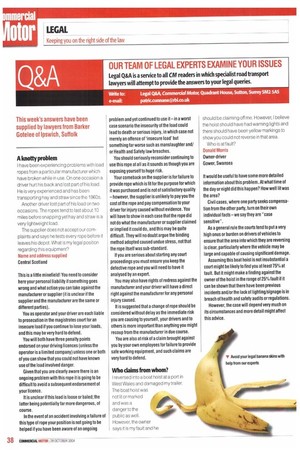This week's answers have been supplied by lawyers from Barker Gotelee of Ipswich, Suffolk
Page 40

If you've noticed an error in this article please click here to report it so we can fix it.
A knotty problem
I have been experiencing problems with load ropes from a particular manufacturer which have broken while in use. On one occasion a driver hurt his back and lost part of his load. He is very experienced and has been transporting hay and straw since the 1960s.
Another driver lost part of his load on two occasions. The ropes tend to last about 10 miles before snapping yet hay and straw is a very lightweight load.
The supplier does not accept our complaints and says he tests every rope before it leaves his depot. What is my legal position regarding this equipment?
Name and address supplied Central Scotland This is a little minefield! You need to consider here your personal liability if something goes wrong and what action you can take againstthe manufacturer or supplier (it is unclear if the supplierand the manufacturer are the same or different parties).
You as operator and your driver are each liable to prosecution in the magistrates court for an insecure load if you continue to lose your loads, and this may be very hard to defend.
You will both have three penalty points endorsed on your driving licences (unless the operator is a limited company) unless one or both of you can show that you could not have known use of the load involved danger.
Given that you are clearly aware there is an ongoing problem with this rope it is going to be difficult to avoid a subsequent endorsement of your licence.
It is unclear if this load is loose or baled; the latter being potentially far more dangerous, of course.
In the event of an accident involving a failure of this type of rope your position is not going to be helped if you have been aware of an ongoing
problem and yet continued louse it — in a worst case scenario the insecurity of the load could lead to death or serious injury, in which case not merely an offence of 'insecure load' but something far worse such as manslaughter and/ or Health and Safety law breaches.
You should seriously reconsider continuing to use this rope at all as it sounds as though you are exposing yourself to huge risk.
Your comeback on the supplier is for failure to provide rope which is fit for the purpose for which itwas purchased and is not of satisfactory quality —however, the supplier is unlikely to pay you the cost of the rope and pay compensation to your driver for injury caused without evidence. You will have to show in each case that the rope did not do what the manufacturer or supplier claimed or implied it could do, and this may be quite difficult. They will no doubt argue the binding method adopted caused undue stress, not that the rope itself was sub-standard.
If you are serious about starting any court proceedings you must ensure you keep the defective rope and you will need to have it analysed by an expert.
You may also have rights of redress against the manufacturer and your driver will have a direct right against the manufacturer for any personal injury caused.
It is suggested that a change of rope should be considered without delay as the immediate risk you are causing to yourself, your drivers and to others is more important than anything you might recoup from the manufacturer in due course.
You are also at risk of a claim brought against you by your own employees for failure to provide safe working equipment, and such claims are very hard to defend.
Who claims from whom?
I reversed into a boat hoist at a port in West Wales and damaged my trailer. The boat hoist was not lit or marked and was a danger to the public aswell, However, the owner says it is my fault and he should be claiming off me. However, I believe the hoist should have had warning lights and there should have been yellow markings to show you could not reverse in that area.
Who is at fault?
Donald Morris Owner-driver Gower, Swansea It would be useful to have some more detailed information about this problem. At what time of the day or night did this happen? How well lit was the area?
Civil cases, where one party seeks compensation from the other party, turn on their own individual facts—we say they are "case sensitive".
As a general rule the courts tend to put a very high onus or burden on drivers of vehicles to ensure that the area into which they are reversing is clear, particularly where the vehicle may be large and capable of causing significant damage.
Assuming this boat hoist is not insubstantial a court might be likely to find you at least 75% at fault. But it might make a finding against the owner of the hoist in the range of 25% fault if it can be shown that there have been previous incidents and/or the lack of lighting/signage is in breach of health and safety audits or regulations.
However, the case will depend very much on its circumstances and more detail might affect this advice.






























































































































































































